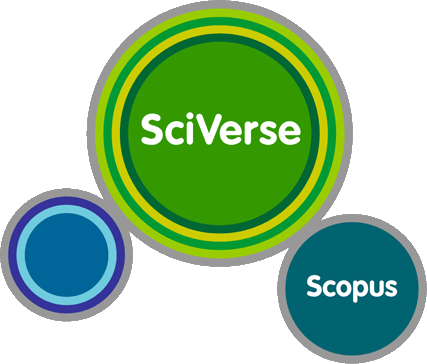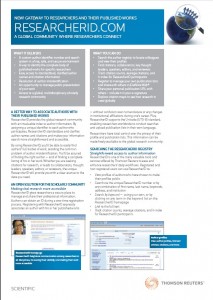 Publishing in journals covered by the main external publication databases, such as Scopus and the Web of Science, will give your research greater visibility and will ensure that citations received are counted in your citation metrics (for example, in your Scopus H-index). The journals that tend to be covered by these external databases are the ones produced by the big publishing houses – Wiley-Blackwell, Elsevier, Springer, etc. These journals are likely to have larger readerships and greater institutional subscriptions than journals published by smaller publishers, which will increase the potential visibility of your research and therefore the potential citations/downloads.
Publishing in journals covered by the main external publication databases, such as Scopus and the Web of Science, will give your research greater visibility and will ensure that citations received are counted in your citation metrics (for example, in your Scopus H-index). The journals that tend to be covered by these external databases are the ones produced by the big publishing houses – Wiley-Blackwell, Elsevier, Springer, etc. These journals are likely to have larger readerships and greater institutional subscriptions than journals published by smaller publishers, which will increase the potential visibility of your research and therefore the potential citations/downloads.
Tagged / Web of Science
Book Citation Index for WoK – 3 month Trial – take part now!
 BU have just enabled a trial of Web of Knowledge Book Citation Index. It will last for 3 months, until 6th August.
BU have just enabled a trial of Web of Knowledge Book Citation Index. It will last for 3 months, until 6th August.
The Book Citation Index allows you to search for books and book chapters using all of the fields and features available in Web of Science. They have added two new indexes to Web of Science:
- Book Citation Index– Science (BKCI-S) — 2005-present
- Book Citation Index– Social Sciences & Humanities (BKCI-SSH) — 2005-present
Key features available when searching for books and book chapters include:
- View citation counts captured for books and book chapters for Citing Articles, Cited References, Related Records, and Shared Records for all available years.
- View citation counts provided to book sources from journal articles and conference-proceedings that cite books and book chapters and vice-versa.
Whilst we don’t currently have a subscription, we are interested in seeing what the coverage is like for BU academics, particularly in the humanities and social sciences that have traditionally experienced less comprehensive coverage by citation databases, although science books are also covered. Please note, not all published books appear here, with concentration on purely research books rather than text books or more populist titles.
There are 143 items listed as having BU Authors:
http://www.bournemouth.ac.uk/library/resources/w.html
Please have a look at what WoK can offer and provide feedback to Emma Crowley: e-mail: ecrowley@bournemouth.ac.uk web site: Library and Learning Support
ResearcherID – an online tool for building a publications profile
What is ResearcherID?
 ResearcherID is a facility provided via the Thomson Reuters ISI Web of Knowledge database. You can register for a unique researcher identification number which enables you to link directly to your published outputs and avoid the common problem of author misidentification. Users can update their profile information, build their publication list by using the Thomson Reuters Web of Science search facilities or by uploading files, and opt to make their profile public or private. Registered as well as non-registered users can search the ResearcherID registry to view profiles and find potential collaborators. You can also now search ResearcherID from within the Web of Science.
ResearcherID is a facility provided via the Thomson Reuters ISI Web of Knowledge database. You can register for a unique researcher identification number which enables you to link directly to your published outputs and avoid the common problem of author misidentification. Users can update their profile information, build their publication list by using the Thomson Reuters Web of Science search facilities or by uploading files, and opt to make their profile public or private. Registered as well as non-registered users can search the ResearcherID registry to view profiles and find potential collaborators. You can also now search ResearcherID from within the Web of Science.
A ResearcherID number is a unique identifier that consists of alphanumeric characters. Each number contains the year you registered.
The benefits of registering for ResearcherID
The main benefit is the ability to build your own custom profile and correctly identify you as the author of your publications. Once registered, you will be provided with the tools to build your publication list by searching ISI Web of Knowledge and Web of Science, or by uploading your own list. You can choose whether or not to make your profile public.
 ResearcherID is also integrated with EndNote Web, so you can build your online publication list either by searching Web of Science or uploading RIS files, or by using the EndNote Web online search. You can also manage your publication list via EndNote Web. For a tutorial on using EndNote Web, click here.
ResearcherID is also integrated with EndNote Web, so you can build your online publication list either by searching Web of Science or uploading RIS files, or by using the EndNote Web online search. You can also manage your publication list via EndNote Web. For a tutorial on using EndNote Web, click here.
Once you’ve put together your publications list, you can then generate the following citation metrics for items available in the Web of Science:
- H-index
- Citation distribution per year
- Total Times Cited count
- Average Times Cited count
These metrics will be automatically updated in ResearcherID from the Web of Science as new data is added to the Web of Science.
ResearcherID can also help you find potential research collaborators by enabling you to search the ResearcherID registry. You can also explore an interactive map that can help you locate researchers by country and topic, or you can use the new country ‘tag cloud’.
Registering for ResearcherID
Go to the ResearcherID homepage then click on ‘Register’ and complete the short online form. You will be sent an email with a link to ResearcherID and a more detailed form appears for you to complete. Once you have completed this, and accepted the terms and conditions, you will receive your unique ResearcherID. Note that you will be sent these details in an email.
When you log in using your ResearcherID and password, you will be taken to your own publications web page with a unique URL. You can include this link on your email signatures so that others can easily access your publications.
Managing your publications
Under ‘MyPublications’ you will have an option to ‘Add’. Alternatively there is an ‘Add Publications’ button on the right hand side of the screen that will take you to the same location. This will give you the three options of searching for or adding a file:
- ISI Web of Science
- EndNote Web
- RIS text file
 Clicking on the publications database will bring up a search screen. Ensure that your surname and initials are correctly entered and click search. Any publications that are already included on your ResearcherID web page will appear in the list and be ticked already. If you wish to add others, tick the relevant box and click ‘Add selections to MyPublications’. The process works the same for all databases. Please note that you need to have an EndNote Web account.
Clicking on the publications database will bring up a search screen. Ensure that your surname and initials are correctly entered and click search. Any publications that are already included on your ResearcherID web page will appear in the list and be ticked already. If you wish to add others, tick the relevant box and click ‘Add selections to MyPublications’. The process works the same for all databases. Please note that you need to have an EndNote Web account.
To delete publications, simply click on the ‘Manage’ button under MyPublications.
For a ResearcherID factsheet, click here.
Symplectic Elements: BU’s new research management system
 I’d like to introduce you to Symplectic Elements – our soon-to-be new research management system. You might have heard colleagues talking about Symplectic Elements for a while now – the supplier (Symplectic Ltd) first visited BU to demonstrate the application in August 2009. I’m pleased to announced that we have now signed the contract with Symplectic and are in discussions with the supplier to determine the implementation plan. The aim is to have the system up and running this autumn.
I’d like to introduce you to Symplectic Elements – our soon-to-be new research management system. You might have heard colleagues talking about Symplectic Elements for a while now – the supplier (Symplectic Ltd) first visited BU to demonstrate the application in August 2009. I’m pleased to announced that we have now signed the contract with Symplectic and are in discussions with the supplier to determine the implementation plan. The aim is to have the system up and running this autumn.
Symplectic Elements is already used by lots of other UK universities, including Imperial College, Oxford, Exeter, Cambridge, UCL and Plymouth.
So what is Symplectic Elements and what benefits will it bring to BU? Symplectic Elements is a research management system. It will not replace any of our existing BU systems (such as BURO or RED) but it will link to them and join them together, sharing data between the systems. This means that BU staff will be able to add information to Symplectic Elements and it will be used in multiple systems. You will also be able to access research information from a single place. A single point of data entry will enable research information (such as publications data) to be automatically formatted and reused in other forums, such as in BU’s open access repository (BURO) and the BU staff profile webpages, without the need for duplicate or additional data entry. You will also be able to query data that appears to be missing or incorrect.
Symplectic Elements will provide academics with a simple ‘dashboard’ from which to view and manage their research information. This will also help when BU begins compiling data to meet the requirements of the REF.
How will Symplectic Elements link with the existing systems?
- Symplectic Elements will link to our Research and Enterprise Database (RED) so you can see your current bids and projects. From within Symplectic you will also be able to link yourself to the PGR students you supervise.
- It will link to BURO so that your research outputs are entered into the repository.
- It will also link to a number of external publication databases (including Web of Science and Scopus) and automatically search these for your publications. When it identifies a paper it thinks might be yours it will send you an email and ask you to confirm it is your paper. If it is then all you will need to do is to tick ‘yes’ and Symplectic will create a record of your publication automatically. You will simply need to add a full-text copy of the paper (copyright permitting) and it will be uploaded into BURO.
- Symplectic Elements will link to the new content management system and you will be able to choose which information is used on your staff profile webpage.
Timeframe for implementation: A broad steering group of representatives from across BU’s Schools and Professional Services has been formed to help feed into and guide the system’s implementation. A core project management group is currently overseeing the day-to-day tasks and will manage the initial data integration and checking. A meeting with the suppliers is scheduled for the end of the month. The system is due to go live in autumn 2011.
Further updates about Symplectic Elements will be posted on the BU Research Blog in due course!












 Upcoming opportunities for PGRs – collaborate externally
Upcoming opportunities for PGRs – collaborate externally BU involved in new MRF dissemination grant
BU involved in new MRF dissemination grant New COVID-19 publication
New COVID-19 publication MSCA Postdoctoral Fellowships 2024
MSCA Postdoctoral Fellowships 2024 Horizon Europe News – December 2023
Horizon Europe News – December 2023